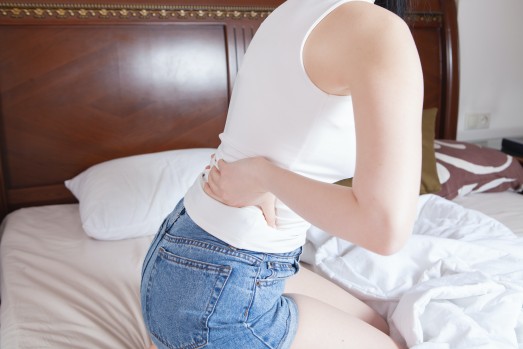Your spine is the pillar that helps you stand tall.
But so you know, your spine is not alone.
It has a complicated set of structures that allows you to stay mobile, bend forward and backward, and rotate to either side.
Research shows that the most important structures in your spine are the discs in-between your vertebrae which are just like cosy cushions that absorb shocks and allow your vertebrae to move comfortably without friction. [1]
Also, there are the joints between your vertebrae themselves.
These joints allow you to move, while keeping your spine stable and well-aligned. [1]
Because these joints look different on different levels, your dorsal spine (upper back) allows only a small degree of bending and rotation.
While your lumbar spine (lower back) is freer to move in both directions.
Research shows that the reason why ranges and freedom of movement are different across the spine is that vertebrae in these regions are different in:
- shape,
- size and
- articulation. [1]
Well, does mobility come at the expense of stability?
Of course not.
Your back is designed to give you both mobility and stability in balance.[1]
In other words, it allows you rotate to the side but not 360 degrees.
To ensure stability, there are several structures that have literally “got your back”!
From the shape of the bones, to the muscles and ligaments around your spine. [1]
With these complicated structure and function, when you have pain originating in your back, it is difficult to tell which structure is causing the pain…
Research shows that it could be:
- Your bones: (e.g., spondylosis, sacroiliitis …etc.)
- Your alignment: abnormal curvatures like scoliosis, kyphosis (or both; i.e., kyphoscoliosis) and hyper-lordosis.
- Your discs: discs can be compressed, reduced, or can bulge out of their place causing symptoms.
- Your ligaments: the ligaments around your spine, most commonly the long one called ligamentum flavum, can become inflamed and cause different types of back pain.
- Your muscles: back pain types of muscular origin can be caused by muscle spasm, imbalance, or muscle strain.
- Your soft tissues: soft tissue restrictions can also cause pain, abnormal posture and limited movement.
- Your internal organs: Your back pain may be referred from organs in your belly or pelvis (e.g., kidney, uterus…etc.) [2]
With all these causes, do you think there is a one-size-fits-all programme to combat different types of back pain?
Of course, there is not!
Because every problem has its own solution that does not apply to other cases.
Not to mention that some exercises for lower back pain can be more of a hindrance than a help when applied for the wrong condition.
For instance, if you sit all day in your London office, and stress yourself out at work, you could strain your back muscles.
When your muscles are strained and acutely inflamed, you may hurt them even more if you stretch them.
This is why it is important to follow a customised rehab programme that addresses your problem and focuses on safely and effectively solving it.
Learn now how Franco, Hayley, Jan, Michaela, Dr Christian NHS, WT police officer, Elizabeth Tiffany Edwards , lawyer M Taylor and Huw completely transformed their life by successfully rehabbing their chronic back pain.
In this article, I will review with you some of the most common types of back pain and explain to you how rehab programmes are different for each type.
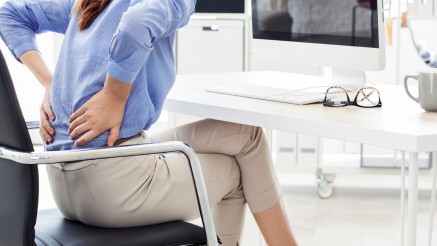
Throughout your reading, you will eventually find out why I created my successful back pain rehab methodology.
And why my laser-sharp customised back pain rehabilitation programmes are the most successful in London and the UK.
Different Types of Back Pain
Back pain is a very general term to describe pain felt in the back.
But… this term is never enough for a professional to decide what you need.
Because simply, a back pain specialist knows that different types of back pain can originate from different structures.
He will also pay special attention to your pain’s:
- Site,
- Nature,
- Onset And
- Severity
- Alleviating and aggravating factors [3]
All these characteristics will help your professional determine the cause and set the right rehabilitation plan for you.
Lower Back Pain: The Most Common Types of Back Pain
Pain felt in the lumbar area and around the hip bones are often called Lower back pain.
Surprisingly, research shows that lower back pain types not only can be caused by problems in your discs, bones and muscles, but also can be referred from your internal organs (e.g., kidneys, ovaries and uterus in females and prostate in males…etc.) [1]
So, What is the cause of my lower back pain?
Usually, your symptom can be a good indicator to find out where your pain originates from.
So, how does your pain look like?
It is important to determine whether your pain is acute or chronic.
Acute pain refers to a recent pain that has been bothering you for less than 6 weeks. [4] This pain is often: It indicates that there is an active inflammation underlying the site of pain. While chronic pain refers to pain that has lasted for a long period of time (more than 12 weeks), [4] and it is usually associated with: If you have low back pain, you should also pay attention to other symptoms you might have because these symptoms complete the picture and help you go the right way towards treating your pain. If you have acute and severe lower back pain, localised to your flank, and referred to your thigh. You are feverish and you have difficulty or pain while peeing, your back pain could be caused by a renal stone, calcification or infection. [5] Another example is: if you have low back pain associated with numbness, tingling, leg weakness, bladder control and muscle spasm, twitching or cramps And you noticed that these symptoms become worse over a period of months or years, Your back pain specialist London based may think of a disc prolapse or spondylolisthesis. [5],[6]
Complete The Picture
For instance,
While –– believe it or not, if you report the same symptoms but you report that they were sudden, after a fall, or an accident, It could be a fracture, or a dislocation in your vertebrae affecting your spinal canal. [5]
This is how much details can change your clinician’s mind!
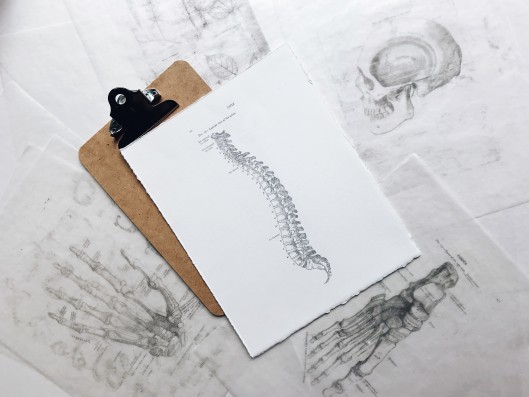
And this is why it is always important to notice –– and report –– all symptoms to your back pain specialist.
Even if these symptoms do not seem relevant to you.
“My symptoms are vague…”
“Why does my back hurt?”
If you have any types of back pain, and your clinician have excluded all possible pathologies and when they cannot find a correlation between your symptoms and imaging, your back pain then is recognised as non-specific back pain. [6]
In this case, just like any other type of back pain, you can benefit from a back pain rehab programme.
And although your back pain is called non-specific, your rehab programme must be specific, and laser-sharp customised for your symptoms and goals.
Prevention is Better Than Cure
Your lower back is at more risk for injury if you are:
- Used to lifting heavy or awkward objects,
- Having abnormal posture such as hyper-lordosis (increased lumbar curve),
- Overweight and obese,
- Physically inactive,
- Have a demanding job that requires too much physical effort,
- Stressed due to work, financial, family and any other problems,
- Used to standing for a long time,
- Being depressed [7]
If you avoid these conditions, or try to solve them, you are less likely to develop lower back pain.
But, if you are already struggling with lower back pain, changing these conditions will help you recover faster and will prevent recurrence.
Treatment and 1-2-1 Rehab
After you complete your diagnosis with your physician or another licensed health professional, you will be referred for physical therapy to start your rehabilitation programme.
Your physiotherapist will use several helpful techniques such as electrotherapy, acupuncture, manual therapy and mobilisation. [8]
Your programme will continue for a while until your acute pain subsides.
After that, if you live in London you can start your customised exercise program for lower back pain either with your physiotherapist or with an expert back pain personal trainer extensively trained in back injury rehabilitation.
If you would like to have a laser-sharp exercise rehab programme that precisely addresses your problems and tackles them one by one.
Once you have a diagnosis and clearance to exercise you can apply for a lase-sharp customised back pain rehab programme.
In this tailored-to-your-needs programme, Jazz Alessi will thoroughly assess you to:
- Detect muscle imbalances
- Detect postural abnormalities
- Go through your lifestyle and habits
- Explore your eating habits and food preferences…Etc.
All these aspects help Jazz understand who you are.
Because simply, this back pain rehabilitation programme will be designed to suit only you.
But, why is Customisation Important?
Suppose you are suffering from lower back pain; you google your symptoms and start performing exercises right away.
However, these exercises might not be right for you and might even worsen your pain.
Or maybe you thought you need to do strength training in order to build a stronger lower back and then you try the hyperextension machine to do so.
Well, this is one of the most common mistakes when you do not have enough details about the cause of your back pain and you cause a long and painful flare-up.
Another common example is when you have a strained muscle in your back and you start stretching thinking that I, if you stretch, you will feel more flexible.
But the truth is, stretching a strained muscle interrupts the healing process and prolongs the time to recovery.
So, does this mean a strained muscle should never be stretched?
In fact, a strained muscle should be stretched at the right time and to the right extent. Depends on the injured muscle, the severity of your injury, and the stage of healing.[9]
So, How to Correct lordosis 12 week program!
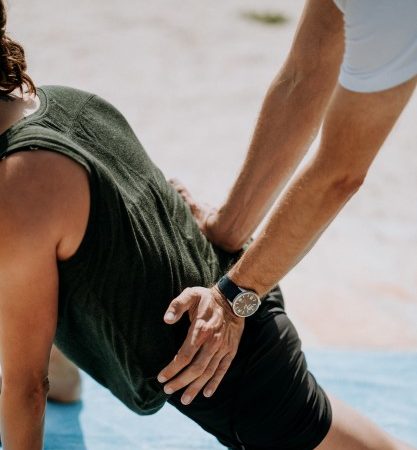
Details matter.
Only a long-term expert rehab personal trainer like Jazz Alessi will pay this much attention to such tiny details.
If you would like to get your own problems solved predictably using a safe, evidence-based and effective back and lordosis exercise program, contact Jazz Alessi.
Apply now for a FREE CONSULTATION
Disc Herniation: The Leading Cause of Pins and Needles
Do you remember the disc between your vertebrae we discussed earlier?
Normally, this disc is composed of two parts, a nucleus inside and annulus around it. [10]
Sometimes, when extra load is placed on these discs, their shapes tend to change.
The whole disc may become shorter and wider, something called disc bulge or disc herniation. [10]
Research shows that when degeneration continues, the nucleus is pushed out of the annulus, and into the spinal canal through a tear or rupture in the annulus.
This case is known as a herniated disc with sequestration. [11]
Discs that become herniated are usually in an early stage of degeneration. The more they are neglected, the worse they become. [10],[11] When a disc has bulged out of its place, it can compress and irritate the surrounding structures giving rise to symptoms like: Although discs do not feel pain, a herniated disc results in different back pain types because it can cause inflammation of the surrounding tissues and can also affect the nerves leading to muscle spasm, tenderness and weakness.[10],[11],[12] When discs compress the surrounding nerves, you will feel numbness or tingling in the area supplied by that nerve. For instance, when a disc in your lower back is herniated, you feel numbness along the well-known sciatic nerve leading to sciatica. However, the site and course of this pain will change if the herniated disc is on a different level.[10],[11],[12] Your muscles receive signals from your nerves. This is how they are ordered to contract, relax and function. When the nerve supplying a muscle is pinched, the muscle does not receive nerve signal, and it shows symptoms like: Disc bulge can occur suddenly with excessive stress on your back. When you have weak core muscles and you lift heavy objects in an improper way your disc may bulge out along with strain or injury. However, even if you have not carried anything heavy, things like: Can lead to disc degeneration and herniation over a long time. So, What is the problem when a disc is herniated?
Back pain
Numbness or tingling
Weakness
So, what are the causes of herniated discs?
Recover from a Herniated Disc –– In Just No Time!
If you have had a herniated disc throbbing down your leg, you have tolerated it enough!
It is time to get rid of your symptoms and go back to your healthy, normal life by following a customised exercise program for herniated disc as a part of a comprehensive herniated disc programme
Only a customised rehabilitation programme designed by a long-term successful back pain specialist will help you recover fast by:
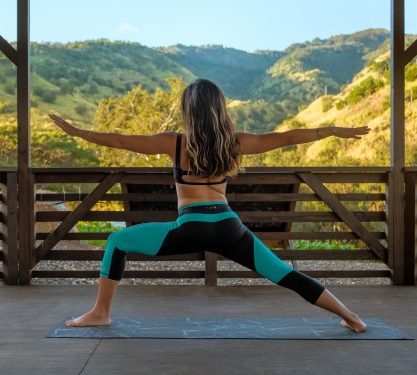
- Tailoring the programme to help you resolve your very own symptoms
- Correcting your spine disorders and misalignments
- Strengthening your core muscles to support your spine
- Safely restoring your flexibility
- Restoring the mobility of your nerves
- Losing weight and adopting a healthy diet
It is true that a laser-sharp rehab programme will help you get rid of your symptoms.
But this is not all!
It will also prevent recurrence after you complete your rehabilitation programme.
But, does this mean online-available herniated disc programmes do not work?
And why do I need a customised programme?
Well, herniated discs are not all the same; they are different in severity, level and shape. [10],[11]
For instance, two people might be suffering from a herniated disc, one of them may experience femoralgia (pain over the anterior part of the thigh) and the other may experience sciatica.
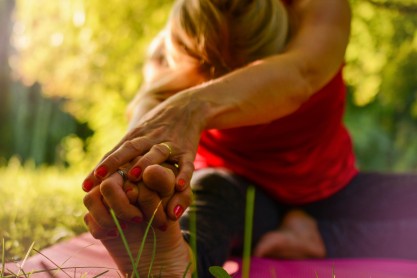
Although both cases are diagnosed with a herniated disc, each of them has his very own symptoms, problems, affected muscles and thus, requires a specific rehabilitation plan.
So, do you think it is time to get your very own problem solved?
This is where Jazz Alessi will help you.
Request your FREE CONSULTATION NOW!
Sciatica Pain: The Pain in The Leg
You wake up in the morning, motivated to get up, prepare breakfast and go to your work on foot instead of taking the bus.
The energetic day looks perfect until you step out of your bed.
Right then, it is all ruined when the numbness comes back, burning from your butt and down your foot.
Then… Change of plans!
Your enthusiasm fades away, you take the bus –– or take a leave –– then spend the rest of the day thinking when you will get to lie down and rest.
This definitely makes you wonder…
When will I get back of this sciatica pain? Before wondering how to get rid of that, you need to understand where this “pain in the leg” comes from. You would say, from my back. But it can also be because of compression on the nerve by non-discogenic structures like hematoma (bruises) and tumours such as Schwannoma (a tumour on the nerve). In addition, your sciatic nerve can be pinched elsewhere down its course by a spasmed muscle like the piriformis. [15] With the proper customised rehabilitation plan, sciatic pain is simply a matter of time. On the other hand, following another person’s sciatica home exercise program will not help you recover –– or may cause you to risk a back re-injury or prolong your recovery. Because as you may have learnt, sciatica pain has different types that require specific rehab programmes. Causes Before Solutions
Well, sciatica can occur because of:
Get Rid of Your Sciatica: 1-2-1 Rehabilitation for Sciatic Pain
Why Customisation Always Matters
Imagine that two people have similar symptoms in the lower back referring to their legs manifesting as sciatica.
But one of them has typical sciatica from a herniated disc and nerve root entrapment, while the other has pseudo-sciatica from a spasm in the piriformis muscle or referred pain from sacro-iliac joint problem.
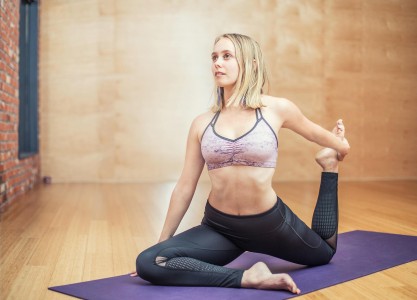
Do you think the programme will be the same for the two?
Of course not!
Each sciatica pain requires its very specific assessment to detect the exact origin of the problem.
If you would like to get a customised sciatica exercise program that targets your symptoms and helps you recover predictably and quickly, it is time to talk to Jazz Alessi – London’s best expert sciatica pain specialist.
Coccyx Pain: Painful Tailbone
You must have heard of coccydynia, a term used to describe pain and tenderness in the bottom of your spine or between your buttocks. [16]
The confusing thing is…
Why is this one of the most overlooked spine disorders?
Does it happen only in females during pregnancy or after childbirth?
Well, these are common misconceptions we need to correct.
Coccydynia occurs in both males and females.
But the fact that it is more common among females makes people think it is a lady-thing. [16]
How Coccydynia Feels Like
Coccydynia has many symptoms in common with other different types of back pain.

But you can still tell this is your tailbone hurting if you have:
- Dull aching pain at the bottom of your spine
- Pain in your buttock
- Pain that increases when you sit or lie down flat
- Referred pain up your back or down your thighs that you cannot locate.
If you think you have tailbone problems, you have to confirm by looking at the causes.
So, what are the causes of a painful tailbone?
There are several reasons behind this dull, aching bum. The most common causes are:
- Poor posture and frequent slouching on narrow, hard, or uncomfortable surfaces.
- Flat back that puts more load on the coccyx while you sit
- Pelvic muscle dysfunction: either spasm or weakness
- Lax ligaments inside the pelvis
- Inflammation in your bone (e.g., osteomyelitis)
- Fractures
- Vaginal childbirth
- Trauma to the coccyx: as if you fall down seated. [16]
Coccydynia Problem Solved: 1-2-1 Customised Rehab Plan
With all these causes, it is difficult to set a plan that suits all people with coccyx pain and bladder problems.
Because each cause would require a specific plan of rehab or treatment.
Research shows that coccydynia can respond to several treatment options including:
- Physiotherapy
- Manual Correction
- Surgical Correction
- Cushions (e.g., wedge or donut cushions)
- Medical treatment
- Coccyx pain exercises [16]
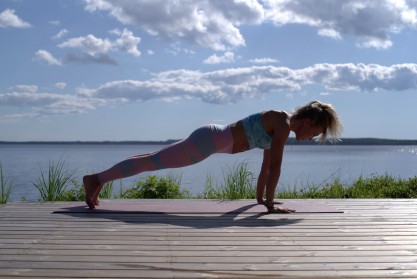
Yet, with all these available options, are they all right for you?
Believe it or not, although these treatment options are all stated in researches as effective, research also shows that some of them might not work for you. [16]
For instance, if you decide to get a donut cushion to relieve pain, your pain may surprisingly become worse.
This does not mean the cushion was bad, it simply means it is not the right option for you.
So, How to Get Rid of Tailbone Pain Real Quick?
The secret to successful coccydynia rehab is “Exercise Rehab Customisation.”
Imagine that you are a male who complains of coccydynia-like symptoms, and you visit your clinician who knows very well that it is uncommon for males to develop coccydynia. So, he immediately excludes this diagnosis without assessment, then he diagnoses you with non-specific low back pain. Do you think your treatment plan will be as effective? Another example is if you and your friend both have tailbone pain due to pelvic floor dysfunction. You might think you are pain buddies and will also be exercise buddies! Then, your expert rehab personal trainer in London surprisingly recommends you totally different exercises. Because his comprehensive assessment revealed that you have pelvic muscle spasm that requires a combination of flexibility and relaxation exercises. While your friend has ligament laxity and pelvic floor drop that requires strengthening and core stability training. That’s right… It is important to get thoroughly assessed so that you get the rehabilitation plan that fits you like a glove. Are you ready yet? It is time to start a laser-sharp rehabilitation plan with Jazz Alessi. Request your FREE CONSULTATION NOW!
Sacroiliac Joint Pain: Is it Always on One Side?
The Sacroiliac joint (SIJ) is the joint connecting your spine to the hip bones.
Which means you have two SIJs on each side of your spine.
People often say that if your back hurts on one side, it is probably your sacroiliac joint.
However, sacroiliac joint inflammation can occur on one or both sides.
In addition, there are other spine disorders that can occur on one side.
So, the myth of “one side = SIJ” is not accurate. The problem with sacroiliac pain is that, it has so much in common with other spine disorders. But… how common is SIJ pain? Well, if your back pain is not originating from a disc problem, research shows that there is a 15-30% chance it is coming from your SIJ. [17] In this case, it is important to look for the following symptoms: Because of these symptoms, SIJ problems are usually misdiagnosed as sciatica or disc herniation, and when MRI shows no significant herniated disc, it is usually misdiagnosed as non-specific low back pain. There is no single reason for all sacroiliac joint pains. However, some causes come on the top of the list. For instance:Sacroiliac Joint: Does it Feel Any Different?
Causes Of Sacroiliac Joint Dysfunction
Sacroiliac Joint Pain: Gone Forever!
Depending on the cause of your SIJ pain or sacroiliitis (inflammation of the sacroiliac joint), your clinician may recommend a combination of:
-
- Medical treatment (e.g., pain killers, anti-inflammatory drugs and muscle relaxants)
- Manual therapy: including mobilisation and manipulation to correct the position of your sacrum bone
- Customised sacroiliac joint pain exercises: a combination of flexibility and strengthening exercises. [17]
Although sacroiliac joint pain may feel like sciatica pain, it’s important not to confuse the two as they are quite different. Unlike sacroiliac joint pain, which is caused due to direct irritation of the sacroiliac joint, sciatica pain is the result of other spinal or muscular conditions that irritate the sciatic nerve. Spinal disorders that cause sciatica pain include disc herniation, spinal stenosis and spinal fractures. Treatment options, too, differ between the two conditions. For instance, nerve flossing for sciatica could be a golden exercise to get rid of leg pain. But, if you spend weeks or even months doing nerve flossing to get rid of leg pain that is referred from your SIJ, believe me, you are not getting anywhere. This is why you need a thorough back pain diagnostic from your sports injury MD and a comprehensive assessment before you receive treatment, or before you start a sacroiliac joint pain UK programme. You want to make sure that you will recover –– and when? If you would like to have an expert’s opinion regarding your back pain transformation, and the right exercises for you, talk to Jazz Alessi, our London expert back pain rehab specialist. Why Do I need a Customised plan?
Thoracic Pain: Pain on a Higher Level
The thoracic region refers to the area between your neck and lower back.
But, what causes thoracic spine pain?
It is true that the thoracic spine is less mobile, more stable and less prone to injuries when compared to cervical and lumbar spine.
However, because it has more structures related to it (e.g., ribs and shoulder blades)
Research shows that there are more causes of thoracic pain than you think. [18],[19]
Here are the most common causes of thoracic pain: As in lower back pain, your thoracic pain might be originating at your bones and soft tissues. Namely, your spine, ligaments, muscles or tendons. However, there are also other structures that may cause thoracic pain or can cause referred pain to the thoracic area. For instance: Thoracic pain can be originated somewhere else in the body and may get you confused thinking that the pain is between your shoulder blades. In fact, when an organ inside your body is having a problem, it gives you vague pain that you may feel in areas away from the original site of the problem. Some of the organs that may refer pain to your thoracic area include: Because the thoracic area is very complicated, symptoms vary greatly according to the onset of affection and nature of the affected structure. On top of all the causes mentioned above, poor habits and posture can be a leading cause of your thoracic pain. They can be the problem itself or they can be worsening the symptoms caused by another problem. 1. Musculo-skeletal Causes
2. Referred Pain
How does thoracic pain look like?
Common symptoms include:
Why do I always have thoracic pain?
These habits include:
Stand Tall: Say Goodbye to Thoracic Pain
Don’t let the vague pain hold you back.
Always look for a thoracic pain specialist in London who will carefully and thoroughly assess your problem and find out where your problem comes from.
As you might have learnt, thoracic pain can have a countless number of reasons, and only an expert in different back pain types will help you do the best exercises to get rid of your symptoms.
Get Your Programme Customised
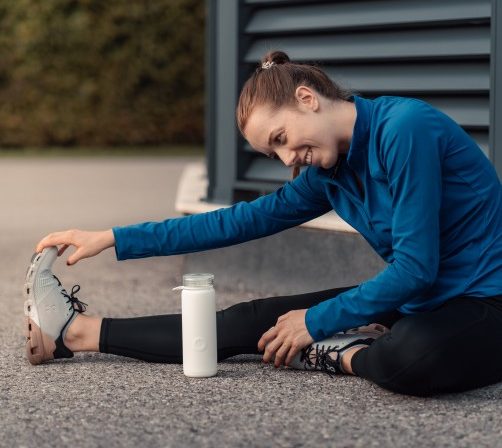
Don’t worry if your thoracic pain specialist recommends you shoulder exercise and chest muscle stretches while recommending neck exercises for your friend who has the same symptoms.
And don’t worry if he recommends someone with the same symptoms to pay a visit to a cardiologist before starting a rehab programme.
This is simply how experts deal with this type of pain, by addressing the problems, and taking the very right action suitable for every client individually.
Do you have a clear diagnosis from your health professional?
Contact us and get and expert’s opinion on what to do for your thoracic pain rehab.
Talk to Jazz Alessi in a FREE CONSULTATION!
Cervical Pain: The “Real Pain in The Neck”
Just like all back pain types, neck pain can have more causes than you can count.
Your pain can simply be caused by strain and overuse, from all the desk work and poor posture you assume all day long.
Or it can be caused by your:
- Discs: Such as herniated or dehydrated discs
- Vertebrae: Such as Spondylosis and bone spurs
- Posture: forward head or abnormal neck curvature will strain your muscles and overload your discs
- Muscles: in cases of overuse or muscle strain.
- Referred pain: your neck pain can be referred from or secondary to a problem in your tonsils, teeth or jaw.[22]
Neck Pain Symptoms
Depending on the nature of your problem, you can experience several symptoms including:
- Pain around the neck area: this may feel like discomfort or tension in your shoulders.
- Headache: tension headache is one of the most common symptoms of neck muscle spasm
- Pain between your shoulder blades
- Limited neck movement
- Numbness down your arms
- Weakness in your shoulder or arm muscles [22]
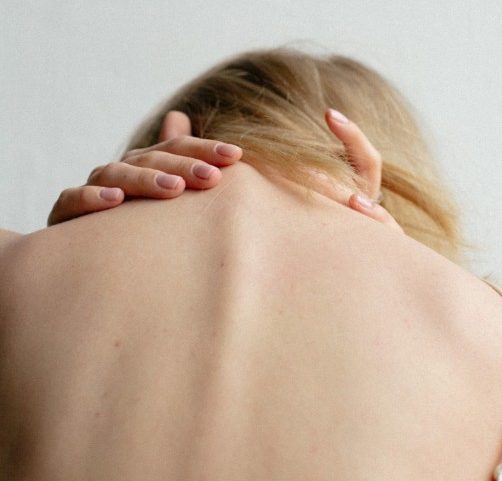
It is important to accurately describe your symptoms because they help your clinician identify the cause of your neck pain. Neck pain can be caused by problems as simple as muscle spasm and stress, or as serious as neck cancer and spinal canal stenosis. To make this clearer, you can think of cervical pain causes as if they fall under one of the following categories: Localised pain in the neck refers to pain that is just felt around the neck and shoulders. This type of pain indicates that the problem is contained in this area. Research shows that your pain can be caused by your trapezius or sub-occipital muscle spasm or inflammation in your vertebrae but, still this is not the full picture. [22] If your neck pain is associated with numbness and pain down the arm, it is most likely caused by a lesion compressing or pinching your nerves like a disc prolapse or spinal canal stenosis. Neck pain might be a bit deceiving; if you have a painful neck with vague pain, you cannot locate it and you do not feel better after neck physiotherapy, your neck pain may be referred from somewhere distant. Research shows that the most common organs referring pain to the neck are:So, what is possibly causing your neck pain?
Localised pain
Cervical pain with radiculopathy
Lesions resulting in narrowing of the spinal canal may also cause symptoms like:
Referred Cervical pain
Beat Your Neck Pain with 1-2-1 Exercise Rehab:
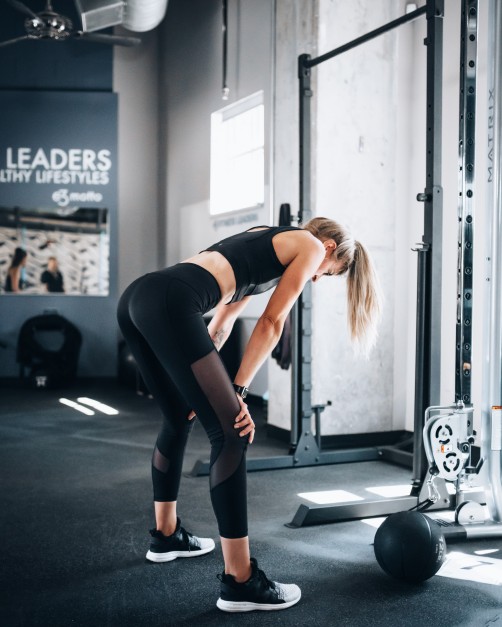
You do not need to tolerate your neck pain for longer.
You have already had enough.
It is time to have a neck-pain-free life using laser-sharp customised home exercise program for neck pain that will help you beat your pain and symptoms.
I bet you are wondering: what type of exercises should I do for my neck?
As you may have noticed, neck problems are countless; each of them requires a different approach and a unique exercise combination.
In a bespoke manner, research shows that this combination often harnesses:
- stretching,
- strengthening,
- postural correction and
- aerobic training. [22],[23]
Which Exercise Suits Me the Best?
There is no typical neck exercise programme for everybody.
For instance, if you and your friend both have a poor neck posture, your problem may sound similar at first glance.
However, comprehensive assessment may reveal that you have an upper-cross syndrome in which there is an imbalance between deep and superficial neck muscles.
While your friend may reveal straight neck curve in which more stretching to the neck extensors is required. [23]
See?
No two people are similar when it comes to neck problems.
This is why it is important to get diagnosed by your MD first. Then, get your very own customised posture, fitness and movement assessment and successful rehab plan to enjoy fast and long-lasting results.
CONSULT JAZZ ALESSI FOR FREE and start your customised rehab.
Kyphosis: The Hump Nobody Wants
You know that you have kyphosis when the top of your back appears more rounded than normal.
It can range from mild to severe kyphosis depending on how flexed your upper back is.
Did you know that… Kyphosis comes with a package of symptoms including pain, discomfort and fatigue. However, poor posture and unpleasant appearance remain the most upsetting symptom associated with it. In addition, kyphosis can make you feel stiff, limit your neck, back or shoulder movement because it changes the alignment of your bones in apposition to one another.[24] There is no single cause for a rounded back. However, the most common causes include:
Symptoms of Kyphosis
If kyphosis is moderate to severe, it can also affect how smooth and easily you breathe leading to:
Causes of A Rounded Back
So, How is Kyphosis treated?
There are many options to treat kyphosis; There is exercising, manual therapy, customised kyphosis rehab, bracing and surgery.
However, kyphosis treatment and rehabilitation plans depend on many factors, mainly:
- The cause of the problem
- Severity of the curve
- Type and reversibility of the deformity
- Your age [24]
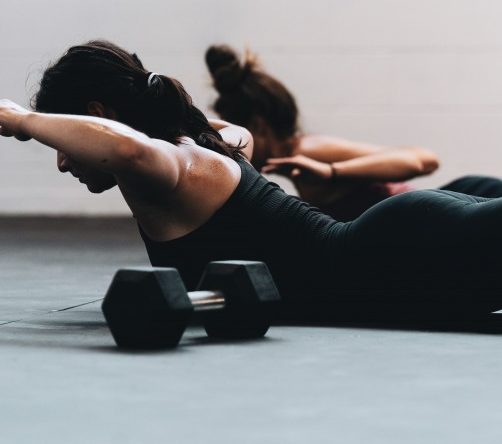
The rehabilitation plan will combine several types of exercises in order to correct your rounded back.
However, it is important to follow a professional rehabilitation programme that is based on a thorough assessment to your individualised case.
Kyphosis is not just a poor posture; in some cases, it is fixed, inflexible and un-correctable by exercise so, make sure you get a correct diagnosis from your MD before starting rehab.
Generally speaking, it is important for your rehab personal trainer to comprehensively assess your case and tell you to which extent exercise will help you.
In some cases, exercise will help you correct your rounded back, while in other cases exercise will only help you improve your symptoms and prevent the curve from worsening.
Your personal trainer might recommend you see an orthopedist if he thinks your rounded back cannot be corrected by exercise.
If you think you have kyphosis, it is time to explore the opinion of an expert.
Jazz Alessi will help you figure out the best way to improve your back curve.
REQUEST A FREE CONSULTATION NOW!
Lordosis: A Curve to Consider
After you have become familiar with kyphosis, which is a rounded back with an outward, convex curve, you might ask yourself…
What is Lordosis?
Lordosis is an inward curve of the spine that is normally seen in the lower back, and in the neck.
Sometimes, this curve may become excessive.
In this case it leads to one of the common spine disorders, called hyper-lordosis. [25]
Hyper lordosis puts more load on your vertebrae and can make you more at risk for vertebral slippage. [25] Because hyper-lordosis means that your vertebrae are not well-aligned together. This strains your ligaments and places more load on your vertebrae. The most common symptom of excessive lordosis is low back pain that increases with standing and walking. Moreover, when the vertebrae are loaded with poor alignment, they may slip and cause narrowing in the spinal canal Also, the discs in between these vertebrae may bulge out and compress the nerves passing by. If you are wondering why your lordosis is increased, here are the most common causes: What are Symptoms of Hyper lordosis?
When the spinal canal and nerve roots are involved, you may experience symptoms like:
So, what causes an excessive lordosis?
Lordosis Exercises: Are They All the Same?
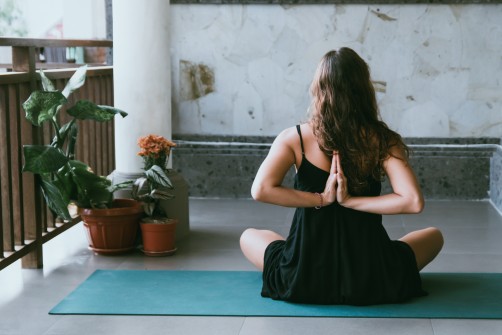
If you look at your back in the mirror and see that you have an increased lumbar lordosis, this can be a simple postural lordosis, or can be spondylolisthesis.
Although both may look the same, the exercises you do for both are completely different.
Spondylolisthesis is the slippage of one vertebra over another leading to an increased curve.
It can also be associated with Pars fracture (small bones that fix vertebrae one over the other)
So, if you have lumbar lordosis because you have tight thigh muscles, you can do lunge stretching.
But in case of spondylolisthesis, this exercise may be dangerous as it may increase the slippage if done excessively.
Bottom line is, looking at the curve is never enough.
You need to have a clear diagnosis from your MD first. Then, undergo a professional evidence-based assessment to determine the exercises that are safe and effective for your case.
If you would like to get your lordosis assessed by an expert back pain specialist who will design an exercise plan for your very specific case.
Request a FREE CONSULTATION NOW!
Scoliosis: The Side-to-side Curve
One of the very common spine disorders is to have your spine curved to one side.
This type of spinal misalignment is called scoliosis.
When your spine has one curve, it is usually called a C-scoliosis because it is bent to the side like a “C” letter. However, when your scoliosis is left untreated, and your spine is bent to the side for long, your body tries to compensate for this curve by bending the rest of the spine to the other side. In this case, you will have two curves looking like an “S” letter, and in this case, your curves will be called an S-scoliosis. [26] Your scoliosis might range in severity anywhere from a mild curve that is hardly seen to a severe curve that not only is visible, but also does interfere with your daily life activities. Now that you have learnt about the scoliosis symptoms, you may wonder what causes scoliosis in the first place. [26] Scoliosis can be caused by abnormally shaped bones, in this case, it appears in a young age and it is called congenital or idiopathic scoliosis; which means scoliosis of an unknown cause. It can also be acquired as a result of a complex muscle imbalance on both sides of the spine. In this case, it can be caused by certain neuromuscular conditions, such as cerebral palsy or muscular dystrophy. Or as a complication of a previous surgery on the chest wall. [26] In some cases, this muscle imbalance can be a result of neglected poor posture and frequent bad habits, like carrying a heavy back on the side, leaning to one side, holding a cane of an improper height or it can occur if you have one leg shorter than the other. So, what are the symptoms of scoliosis?
Generally speaking, scoliosis can cause the following symptoms:
What is the main cause of scoliosis?
All Scoliosis Cases Are Not The Same
Scoliosis is not only about a spine bent to the side.
It requires complex analysis to understand:
- Which is the main curve (the curve that started first)
- Which is the secondary curve (that developed as a compensation)
- Whether it is fixed or correctable
- How severe your scoliosis is (e.g., by measuring the cobb’s angle)
- Whether it includes rotation of the vertebrae
- How involved your ribs are [26],[27]
With all these factors to consider, it is impossible to have the same scoliosis rehab programme for all cases.
For instance, in some cases, a brace might help, while in others, it is not recommended.
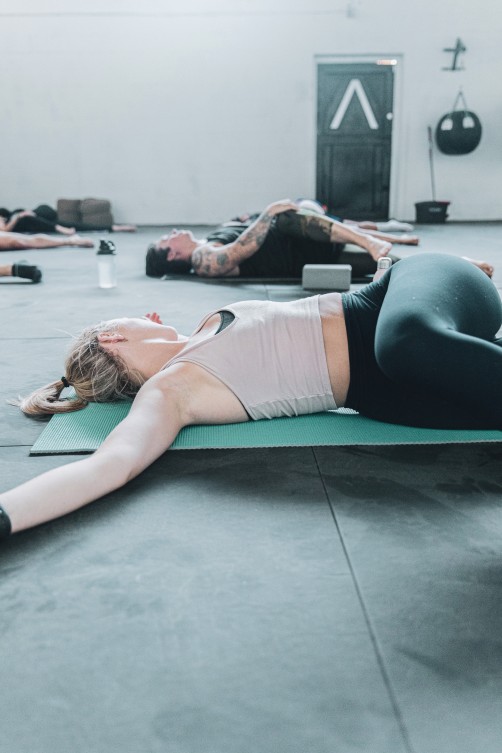
In addition, scoliosis is a deformity of the spine and should not be confused with poor posture.
It could be very dangerous to perform Posture correction exercises right away without getting specific Rehab for Scoliosis.
Therefore, it is advised to consult an Expert.
- Do you have a clear diagnosis from your sports injury MD?
Would you like to start scoliosis home exercise program but you are worried about safety of the exercise program for scoliosis?
If you have a clear diagnosis.
Jazz Alessi can guarantee not only a safe, but also an effective scoliosis rehab plan that is designed based on your very specific case.
Request a FREE CONSULTATION with Jazz now!
Degenerative Disc Disease (DDD)
When we grow older, a continuous process of wear and tear occurs in our discs.
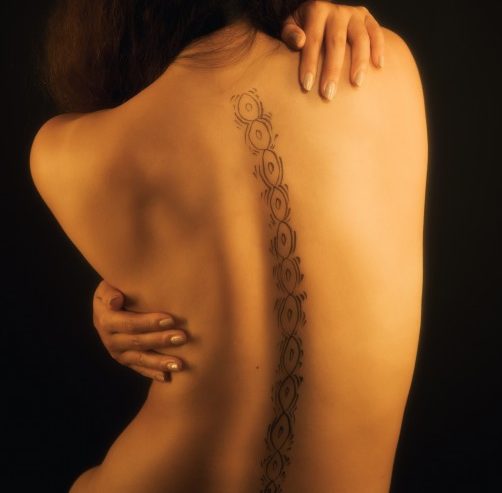
In other words, collagen content, volume and height of discs decrease, discs dry out and shrink. [28],[29]
This process can occur anywhere in your spine from your neck to your lower back, but it is most common in the cervical spine (neck) and the lumbar spine (lower back) because these two are the most mobile parts of your spine. [28]
Thus, they bear more weight and undergo more friction than the dorsal spine.
What are the symptoms of degenerative disc disease?
Well, one of the reasons is that the vertebral discs degenerate and lose much of their heights. As a result, the whole length of the spine becomes shorter. Now that you can recognise DDD back pain, it is time to think of joining a comprehensive rehab plan that will help you relieve your symptoms and improve your function. All you need is a customised exercise plan that tackles your problems and meets your goals. So, if you are feeling shorter, this could be a symptom of DDD. In addition to:
But… Why is Customisation Important?
If you are wondering why you need to have your own customised plan, you need to understand what happens when your disc wears away.
Degenerative disc disease –– also called Spondylosis results in different changes in discs and vertebrae, and it is completely different from spondylolisthesis in which a vertebra slips over another.
- In the first case, your rehab personal trainer will combine some gentle extension exercises with breathing to help you restore and maintain your flexibility and mobility.
- While in the second case, extension exercises are harmful as they can increase the slippage and lead to serious complications.
So, do not follow any exercise rehab plan you see over the internet.
Instead, get your own customised degenerative disc disease exercise program with Jazz Alessi – the best back pain rehab specialist in London.
BOOK YOUR FREE CONSULTATION NOW!
Spondylitis: Spine arthritis
There is a common misconception that spondylosis and spondylitis are the same.
However, there is a huge difference.
As we have just mentioned, spondylosis is a process of age-related wear and tear that occurs with aging.
On the other hand, spondylitis is a state of inflammation that occurs in the spine.
Thus, it is called spine arthritis.
In spine arthritis, the facet joints (small joints between vertebrae) become inflamed, swollen and limited in range. [30]
So, What are the Symptoms of Spine arthritis?
You might have guessed that inflamed joints will become painful.
So, the first symptom expected is spine pain anywhere from the neck to the lower back.
In addition, you may experience stiffness and decreased mobility.
In some cases, if the nerves are pinched by a disc, swelling or bone spurs, you may experience numbness in the legs or arms. [30]
Usually, you might be prescribed a combination of flexibility, strengthening and aerobic exercises to alleviate the symptoms and improve your condition.[31]
Different Conditions; Different Rehab
Spondylitis, Spondylosis, Spondylolisthesis, spondylolysis….
All of these are completely different conditions have names –– and also symptoms –– that make them look alike.
However, although both spondylosis and spondylitis are both arthritic, there is a huge difference in how each of them develops.
This is why they will require different approaches during their rehabilitation.
If you would like to successfully rehab with a specialist rehab personal trainer who understands your condition from inside out and designs the best exercise plan based on your very own condition.
You can talk to Jazz Alessi.
Request your FREE CONSULTATION NOW!

Spine Osteoporosis: Fragile Spine
Bone loss is one of the most common signs of aging that is seen in the thigh bone, hips and forearms.
And the spine is not an exception.
In fact, research shows that the vertebrae are one of the bones that commonly lose their density and strength as we grow older. [32]
In this case, your vertebrae become fragile as they lose calcium. Which makes you more at risk for developing osteoporotic symptoms. [32] Do you remember how degenerative disc disease could make you shorter by giving you thinner discs? Spine osteoporosis can also do the same by giving you fragile, compressed vertebrae. This is one of the symptoms you may notice with spine osteoporosis. However, being shorter might not be as troubling as the rest of the symptoms. Although fragility of bones in general and the spine in particular is one of the common age-related changes, there are risk factors that make you more at risk of developing fragile bones. Following the right rehabilitation plan can strengthen your bones and reduce your risk of fracture. All you need to do is follow a customised nutrition plan rich in minerals, essential fats, and vitamins in addition to a safe exercise plan that focuses on getting calcium inside your bones. This plan might include low-impact, weight bearing exercises like walking, jogging and running in addition to gradual strengthening exercises with bodyweight or external resistance. [34] What are the Symptoms of a Fragile Spine?
Those are:
So, why is my Spine fragile?
For instance:
Stronger Bones: Is It Possible?
Take Care: Your Programme Must Be Right

Spine osteoporosis has symptoms just similar to many other spine conditions like spondylosis.
However, if you have spine osteoporosis, programmes that are given to other spine disorders might put you at risk of breaking your vertebrae or worsening your symptoms. [33],[34]
This is why it is important to get your own customised exercises for osteoporosis of the spine designed by UK’s Top Nutritionist and specialist rehab trainer.
Jazz Alessi is there to support you.
Request your FREE CONSULTATION NOW!
Spine Misalignments
Everybody dreams of a model-like posture, standing tall with the shoulders pulled back.
I bet you have also tried to stand tall and noticed how better and more confident you felt.
The problem is, after a couple of minutes, you get tired and you slouch back to a poor posture you feel is more comfortable, no matter how unnatural it looks.
If this happens to you a lot, you might be having a spine misalignment. When you assume a poor posture for a long period of time, your muscles, ligaments and fascia adapt to the bad posture by switching off, becoming overactive, shortening or weakening. For instance, if you work on a desk for long, your chest muscles shorten and your back muscles become weak while your ligaments become lax. By the passage of time, the alignment of your spine also gets affected by the imbalance in your soft tissues. [35] Spine misalignment can be subtle, it can occur on the level of several vertebrae or one vertebra that may become rotated, stuck or less mobile. Your spine misalignment can also affect joints like your knees and ankles. [36] Well, regarding this… I have bad and good news for you… But…What are spine misalignments?
So, How do you know If you have One?
You may experience the following symptoms:
Will it always be the same?
So, what does personalised rehab mean?
And why is it important?
Spine misalignments are not all the same.
You could have one vertebra rotated to the left, or to the right
You could have sub-laxation or instability.
You could have facet joint dysfunction
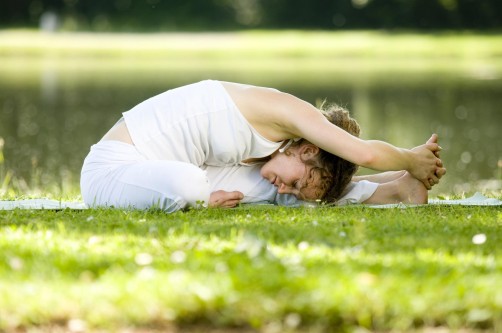
Each problem is just like a door lock that has its very own key. For instance, a locked facet joint can be corrected by spinal manipulation done by a chiropractor. But, if you have spinal instability, your chiropractor will refuse to manipulate your vertebrae and will refer you to an expert rehab personal trainer to improve your core stability. This is an example that there is no one-programme-fits-all for spinal misalignments. And this is why it is crucial to follow a very specific set of exercises based on the type and severity of your misalignment.
So, you do not know what the problem is, but you know something is wrong?
Get assessed by an expert back and spine rehab specialist, just like Jan, Hayley , Franco , Michaela or Dr Christian , WT MET Police Officer and Tiffany who had doubts and only after complete checks, we could proceed for a specific course of actions.
And now they are all enjoying life at full!
Customised Exercise Program for Different Types of Back Pain
You must have read through this article feeling that all back pains cause the same symptoms.
And you must be thinking that it is impossible to tell which back pain type you have. But do not worry! All you need to do is to get a clear diagnosis from your sports injury MD first, then share the tiniest details about your symptoms with an expert spine rehab specialist like Jazz Alessi. And he will take it from there. For Jazz, every symptom you complain of, and every word you use to describe you pain makes sense. He will translate your complaints to an evidence-based combination of nutrition and exercise in order to successfully help you tackle your problems and provide you with the best results in no time.
Who Is Jazz Alessi?
Jazz Alessi is a long-term specialist rehab personal trainer that creates successful customised solutions for each one of his clients.
He believes that all types of back pain are a torture nobody should have to tolerate.
This is why, after getting your MD diagnosis and medical clearance to rehab, he dedicates quality time and effort to professionally assess you as a valuable client using the best evidence-based practice you will find in London.
Then, he designs a back rehab programme solution specifically made to solve problems at the root rather than simply improve symptoms.
This is why Jazz’s programme gives you long-term results, helps you successfully recover from your back pain injury and moves you safely (safe is a keyword) into athletics and practicing sports and prevents recurrence.
FAQs
1. How does the programme work?
After you have been diagnosed and have clearance to exercise by your physician, this programme will comprehensively assess your problems to detect the imbalance between your body parts, postures, muscles, joints and ligaments etc. Then, through a customised successful process, you will enjoy a combination of exercise (and diet) aiming at improving your symptoms on the short-term, and prevent them from coming back on the long-term.
2. How will I access my Personalised Back Pain Rehab Programme?
Back Pain Rehab Programme is designed to fit into your life schedule. You can participate and get engaged with our programme online, where your rehab personal trainer will keep in touch, provide live sessions and follow-up your progress.
Or you can choose to meet up with your personal trainer in your London office, in a gym, in a London park or at your place wherever you live in London.
That is right! Convenience is our thing!
3. What are the prerequisites?
Diagnosis and clearance to exercise. Before getting started, you must get approval from your physician to participate in a rehabilitation programme. This and your willpower! This is all you need to recover with us.
4. I have other health issues; can I still join this Back Pain Rehab Programme?
You must get approval from your physician that you can participate in a rehabilitation plan. After that, don’t worry, Jazz Alessi is a long-term expert rehab personal trainer who creates from scratch the best personalised back pain rehab plan that not only does suit your health conditions, but also improves them.
5. Is this Program suitable during pregnancy?
Obstetricians often recommend taking part in an exercise pre-natal plan that helps you relieve your back pain, strengthen your muscles, boost your mood and make your delivery easier.
However, all cases are not the same, this is why it is important to first consult your Obs & Gyn to find out whether it is OK for you to take part.
6. Should I avoid manual treatment during this Programme?
Manual treatment is a helpful technique that can help relieve your muscles. So, it is not contraindicated with this programme. However, with this comprehensive laser sharp customised programme, you will regain your flexibility, strength and relax your muscles without the need for manual treatments.
7. Will exercising make my back pain worse?
The wrong exercises will make your pain worse. But with our programme, every exercise you will do is assessment-based and it fits you like a glove for your rehab case. The selected, customised exercises will make you feel better, more flexible and stronger and more balanced and will never worsen your back pain.
8. For Offline Training, Do I need to bring anything?
Depending on your exercise plan, Jazz may ask you to bring a Pilates or Yoga mat. However, you will be informed at the right time. For now, all you need to do is show up, and let your successful back pain recovery begin.
Keen to get started?
REFERENCES
1. The thoracic and lumbar spine. Norkin C.C., & White D(Eds.), (2009). Measurement of Joint Motion: A Guide to Goniometry, 4e. McGraw Hill. https://fadavispt.mhmedical.com/content.aspx?bookid=1964§ionid=147191685
2. Yasufumi HAYASHI (2004): Classification, Diagnosis, and Treatment of Low Back Pain JMAJ 47(5): 227–233, 2004
https://www.med.or.jp/english/pdf/2004_05/227_233.pdf
3. Concannon, Michael & Bridgen, Andy. (2011). Lower back pain: a need for thorough assessment. Practice Nursing. 22. 458-463. 10.12968/pnur.2011.22.9.458.
https://www.researchgate.net/publication/272543889_Lower_back_pain_a_need_for_thorough_assessment
4. The university of York: Effective Health Care: Acute and chronic low back pain
https://www.york.ac.uk/media/crd/ehc65.pdf
5. Chris Hoffman and John MacVicar: Acute low back pain, BPJ | Issue 21
https://bpac.org.nz/BPJ/2009/June/lowbackpain.aspx
6. Panjaitan, Lucky. (2020). A brief review in Non-Specific Low Back Pain: Evaluation and Physiotherapy Intervention. International Journal Medical and Exercise Science. 6. 760-769. 10.36678/ijmaes.2020.v06i03.001.
https://www.researchgate.net/publication/344348312_A_brief_review_in_Non-Specific_Low_Back_Pain_Evaluation_and_Physiotherapy_Intervention
7. Dijken, Christina & Fjellman Wiklund, Anncristine & Hildingsson, Christer. (2008). Low back pain, lifestyle factors and physical activity: A population-based study. Journal of rehabilitation medicine : official journal of the UEMS European Board of Physical and Rehabilitation Medicine. 40. 864-9. 10.2340/16501977-0273.
https://www.researchgate.net/publication/24039918_Low_back_pain_lifestyle_factors_and_physical_activity_A_population-based_study
8. A, Basson. (2011). Physiotherapy management of low back pain –a review of surveys. South African Journal of Physiotherapy. 67. 17-20. 10.4102/sajp.v67i1.246.
https://www.researchgate.net/publication/266603427_Physiotherapy_management_of_low_back_pain_-a_review_of_surveys
9. Hassan, Karima & Abdelrahman, Marwa & Fayaz, Nadia & Abdelkader, Nasr. (2021). Effect of stretching exercises in treatment of muscle strain: A systematic review.
https://www.researchgate.net/publication/349590902_Effect_of_stretching_exercises_in_treatment_of_muscle_strain_A_systematic_review
10. Raj, Phulchand. (2008). Intervertebral Disc: Anatomy-Physiology-Pathophysiology-Treatment. Pain practice : the official journal of World Institute of Pain. 8. 18-44. 10.1111/j.1533-2500.2007.00171.x.
https://www.researchgate.net/publication/5639314_Intervertebral_Disc_Anatomy-Physiology-Pathophysiology-Treatment
11. Mathur, Mudit & Jain, Nikhil & Sharma, Saksham & Rawall, Saurabh & Sharma, Shiv. (2020). Lumbar Disc Herniation: A review article. IP International Journal of Orthopaedic Rheumatology. 6. 1-11. 10.18231/j.ijor.2020.001. https://www.researchgate.net/publication/343011138_Lumbar_Disc_Herniation_A_review_article
12. Luchtmann, Michael & Firsching, Raimund. (2016). Lumbar disc herniation: Evidence-based guidelines–a review. The Indian practitioner. 69. 36-41.
https://www.researchgate.net/publication/301290876_Lumbar_disc_herniation_Evidence-based_guidelines-a_review
13. Dr. Neamat Allah Gomaa Ahmed1; Dr. Amal Bakr Abo El-Ata; Dr. Hedaya Mohamed Hendam; Sara Alasmer Mohamed (2020):SELF CARE PRACTICES OF PATIENTS WITH LUMBAR DISC PROLAPSE IN THE POSTOPERATIVE PERIOD; Vol.7, No.2 ,June 2020
https://pssjn.journals.ekb.eg/article_94767_7f47d1e99b5f7f5861346880e6b12241.pdf
14. Aouad D, K, Rahi R, Maalouly J, Ayoubi R, A, Saade J, Wehbe J: Non-Resolving Sciatica Due to Sacroiliac Joint Osteophyte Compressing the Sciatic Nerve in a Young Patient: A Case Report and Literature Review. Case Rep Orthop Res 2021;4:43-48. doi: 10.1159/000511305
https://www.karger.com/Article/FullText/511305#
15. Thiyagarajan, Senthilkumar. (2017). Pseudo Sciatica-It’s the Condition we really Treat Better than Medicine. Journal of Novel Physiotherapies. Volume 7. 10.4172/2165-7025.1000327.
https://www.researchgate.net/publication/313728545_Pseudo_Sciatica-It’s_the_Condition_we_really_Treat_Better_than_Medicine
16. Mabrouk, Ahmed & Alloush, Almothenna & Foye, Patrick. (2020). Coccyx Pain (PMID: 33085286). StatPearls Publishing, Treasure Island (FL).
https://www.researchgate.net/publication/344807948_Coccyx_Pain_PMID_33085286
17. Tilvawala, Khushali & Kothari, Kailash & Patel, Rupal. (2018). Sacroiliac joint: A review. Indian Journal of Pain. 32. 4. 10.4103/ijpn.ijpn_18_18.
https://www.researchgate.net/publication/324945347_Sacroiliac_joint_A_review
18. Singla, Deepika & Veqar, Zubia. (2017). Association Between Forward Head, Rounded Shoulders, and Increased Thoracic Kyphosis: A Review of the Literature. Journal of Chiropractic Medicine. 16. 10.1016/j.jcm.2017.03.004.
https://www.researchgate.net/publication/320103603_Association_Between_Forward_Head_Rounded_Shoulders_and_Increased_Thoracic_Kyphosis_A_Review_of_the_Literature
19. Boulder Neurosurgical & Spine Associates Justin Parker Neurological Institute (2015): Evaluation and Management of Thoracic Spine Pain in the Primary Care Setting; v.2, e1
https://www.bnasurg.com/downloads/BNA-newsl-0115-300.pdf
20. Kleef, Maarten & Stolker, Robert & Lataster, Arno & Geurts, José & Benzon, Honorio & Mekhail, Nagy. (2010). 10. Thoracic Pain. Pain practice : the official journal of World Institute of Pain. 10. 327-38. 10.1111/j.1533-2500.2010.00376.x.
https://www.researchgate.net/publication/44620805_10_Thoracic_Pain
21. Koszela, Kamil & Krukowska, Sylwia & Marta, Woldanska-Okonska. (2017). Back pain as a lifestyle disease. Pediatria i Medycyna Rodzinna. 13. 344-351. 10.15557/PiMR.2017.0036.
https://www.researchgate.net/publication/320953362_Back_pain_as_a_lifestyle_disease
22. orenstein D (2013). Chapter 9. approach to the patient with neck pain. Imboden J.B., & Hellmann D.B., & Stone J.H.(Eds.), CURRENT Diagnosis & Treatment: Rheumatology, 3e. McGraw Hill.
https://accessmedicine.mhmedical.com/content.aspx?bookid=506§ionid=42584892
23. Bradley Gueldner Dr. Dana Gueldner, Morgan Gueldner, George Ferguson Way: Postural Correction for Neck and Back; Abbotsford, British Columbia.
http://www.clearbrookchiropractic.ca/wp-content/uploads/2018/05/Rehab-Upper-Crossed-Syndrome.pdf
24. Yaman, Onur & Dalbayrak, Sedat. (2014). Kyphosis and Review of the Literature. Turkish neurosurgery. 24. 455-465. 10.5137/1019-5149.JTN.8940-13.0.
https://www.researchgate.net/publication/264125789_Kyphosis_and_Review_of_the_Literature
25. Dimitrijevi´c, V.; Š´cepanovi´c, T.; Milankov, V.; Milankov, M.; Drid, P. Effects of Corrective Exercises on Lumbar Lordotic Angle Correction: A Systematic Review and Meta-Analysis. Int. J. Environ. Res. Public Health 2022, 19, 4906.
https:// doi.org/10.3390/ijerph19084906
https://www.mdpi.com/1660-4601/19/8/4906/pdf?version=1650274807
26. Esposito, Teresa & Varriale, Bruno & DiMartino, G.F. & Chierchia, M. & Carnevale, A. & Ronca, D.. (2012). Scoliosis: Causes, genetics, symptoms, and treatment in a southern Italy population. Scoliosis: Causes, Symptoms and Treatment. 1-47.
https://www.researchgate.net/publication/286126709_Scoliosis_Causes_genetics_symptoms_and_treatment_in_a_southern_Italy_population
27. Weiss, Hans-Rudolf & Turnbull, Deborah & Tournavitis, Nicos & Borysov, Maksym. (2016). Treatment of Scoliosis-Evidence and Management (Review of the Literature). Middle East Journal of Rehabilitation and Health. In Press. 10.17795/mejrh-35377. https://www.researchgate.net/publication/297726111_Treatment_of_Scoliosis-Evidence_and_Management_Review_of_the_Literature
28. Choi, Yong-Soo. (2009). Pathophysiology of Degenerative Disc Disease. Asian spine journal. 3. 39-44. 10.4184/asj.2009.3.1.39.
https://www.researchgate.net/publication/43202233_Pathophysiology_of_Degenerative_Disc_Disease
29. The Iowa Clinic: Degenerative Disc Disease:
https://www.iowaclinic.com/webres/File/degenerative-disc-disease.pdf
30. Gellhorn, Alfred & Katz, Jeffrey & Suri, Pradeep. (2012). Osteoarthritis of the spine: The facet joints. Nature reviews. Rheumatology. 9. 10.1038/nrrheum.2012.199.
https://www.researchgate.net/publication/233405246_Osteoarthritis_of_the_spine_The_facet_joints
31. Chang HJ, Lynm C, Glass RM. Osteoarthritis of the Lumbar Spine. JAMA. 2010;304(1):114. doi:10.1001/jama.304.1.114
https://jamanetwork.com/journals/jama/fullarticle/186172
32. Varacallo, Matthew & Fox, Edward. (2014). Osteoporosis and Its Complications. Medical Clinics of North America. 98. 10.1016/j.mcna.2014.03.007.
https://www.researchgate.net/publication/262196419_Osteoporosis_and_Its_Complications
33. Pouresmaeili, Farkhondeh & Dehghan, Behnam & Kamarehei, Maryam & Goh, Yong. (2018). A comprehensive overview on osteoporosis and its risk factors. Therapeutics and Clinical Risk Management. Volume 14. 2029-2049. 10.2147/TCRM.S138000. https://www.researchgate.net/publication/328752903_A_comprehensive_overview_on_osteoporosis_and_its_risk_factors
34. Dionyssiotis, Yannis. (2012). Rehabilitation in Osteoporosis. 10.5772/29205. https://www.researchgate.net/publication/221925769_Rehabilitation_in_Osteoporosis
35. Shah, Anoli & Lemans, Justin & Zavatsky, Joseph & Agarwal, Aakash & Kruyt, Moyo & Matsumoto, Koji & Serhan, Hassan & Agarwal, Anand & Goel, Vijay. (2019). Spinal Balance/Alignment – Clinical Relevance and Biomechanics. Journal of Biomechanical Engineering. 141. 10.1115/1.4043650.
https://www.researchgate.net/publication/332832674_Spinal_BalanceAlignment_-_Clinical_Relevance_and_Biomechanics
36. Oshima, Yasushi & Watanabe, Nobuyoshi & Takai, Shinro & Kawata, Mitsuhiro. (2019). Abnormal Posture Relating to the Alignment of Spine and Lower Extremity. Advances in Orthopedics. 2019. 1-2. 10.1155/2019/8460364.
https://www.researchgate.net/publication/334705855_Abnormal_Posture_Relating_to_the_Alignment_of_Spine_and_Lower_Extremity



